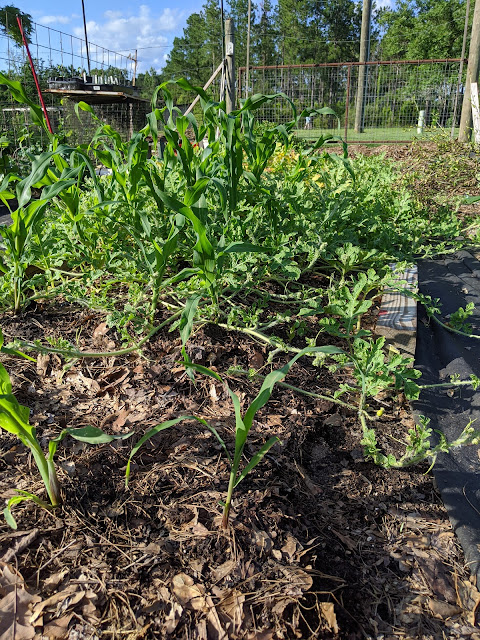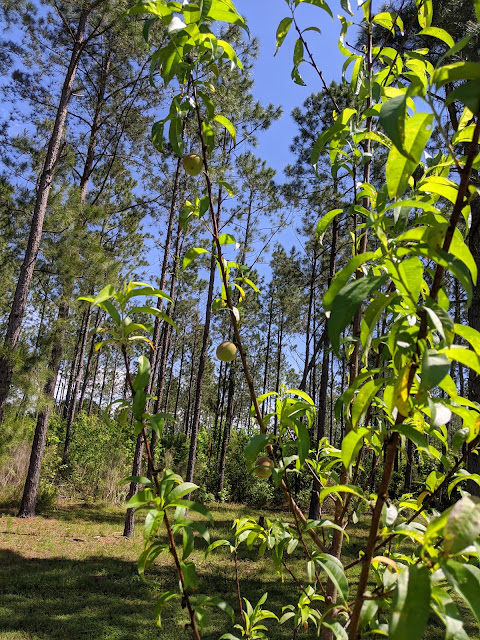On Monday we'll have had our guineas for a year, picking up 18 of them as week-old keets. We've certainly enjoyed them, but some of the local wildlife (namely coyotes and possibly foxes) has not been kind. Our numbers have recently dwindled to 7. Not good.
Guineas are not fully domesticated so trying to keep them penned up will not work. They need to roam. Now that warmer temps are upon us the guineas are in the mood for love and that love leads to laying eggs and laying eggs leads to getting broody and wanting to sit on a nest...usually hidden in the weeds/woods somewhere...once there are about 30+ communally-laid eggs in that nest.
 |
| A nest that is about halfway full |
We've managed to find most of the nests and have tried to protect them, but even so, the Mama guinea leaves the nest early in the morning to eat and that seems to be when they are killed. I have no idea how they have survived in the wilds of Africa. So from the newest nest we began to take the most recent eggs and put them in here:
 |
IncubaTRON 5000XL Gold Extreme (not really)
|
We figure if we're going to lose them to predators, we might as well try to replace them, if we can. We just started the incubator a few days ago, and then...
One of our chickens went broody on us. She's smart enough to stay in the coop on her eggs in the nesting box, safe and sound. But the joke's on her as our rooster has been dead and gone for two months, so she's trying to hatch duds. This means, we have a second incubator for our guinea eggs. We just have to convince her to sit on them.
 |
| That looks says "Don't start nothin', won't be nothin'!" |
I've seen videos and read blogs about dealing with a broody hen. She will guard her eggs and isn't happy to have someone messing with her while she's trying to raise a family. She'll peck, snarl, make strange noises and do all within her power to keep you away. I'm sure if she had a grenade or rocket launcher, she'd use it. Keeping this in mind, I'm sure she didn't want me reaching in and switching her eggs for some new guinea eggs. But we had to try, right?
We gathered the three newest (today) eggs on the guinea nest and headed to the coop. Our plan was for me to reach in and grab the hen, wearing work gloves of course, while Neta removed the old chicken eggs and replaces them with the guinea eggs. Sounds easy enough.
Believe it or not, it was. She pecked me once (on the glove), but was very docile other than making an otherworldly noise when I picked her up that may have been summoning some ancient chicken demon or putting some fowl curse on me. Neta swapped out the eggs and I put her back in the nesting box. She (the chicken, not Neta) re-arranged the eggs a bit, then settled down on top of them just like nothing had changed. Now, we hope she can be patient enough to sit on them for 28 days, since chicken eggs only take about 21 days. Fingers crossed.
In Other News...
On the fruit and veggie front our garden and fruit trees have been doing quite well. We got our first peaches a few weeks back. Our trees are still small. The later one has 4 peaches on it but they aren't ripe yet. The early one also had 4 edible peaches which we turned into peach milkshakes two nights in a row. YUM!!!
 |
Our La Feliciana Peach (the later one). Hopefully they'll get bigger
and be ripe in a few more weeks. |
Our apple tree (an Anna apple we think) has about 10 or so fruit on it. One ripened early and we enjoyed it a couple of nights ago. That was a highlight as apples don't do well in the south with so much heat. This apple was firm with smooth white flesh and just slightly tart. We're looking forward to more of this.
 |
| It wasn't this apple. We ate it before thinking to take a picture. |
Our blueberries are peaking right now. They'll keep going until the first week or so of July.
 |
Pure Goodness!
|
Neta has used them with some of the wild blackberries she's picked to make "Black & Blue Jam". Quite tasty. But they're hard to beat directly off the bush.
We'll finish up with a tour around the vegetable garden. This year Neta has nearly perfected things. The garden is nearly weed-free through her use of cardboard and weed-stop cloth in-between the rows, and lots of mulch and pine straw around the plants coupled with an array of soaker hoses to help keep things watered. Here's what we have going:
Asparagus - This is its 2nd year. Not quite ready for harvesting. It will be established enough next year. It's still putting all of its effort into growing and expanding its root system.
 |
Asparagus, fronted by painted gourds on thick branches (ask Neta)
|
Leeks - We harvested them a couple of months ago. We're letting a few go to seed to replant for next year. The pollinators love the blooms.
 |
Leeks
|
Tomatillos - They've struggled a bit this year. Could be too much recent rain. We'll keep you posted on them.
 |
| Tomatillos |
Peanuts - Jimmy Carter isn't the only peanut farmer in Georgia. We grew a few last year. Just enough to make us want to try it again.
 |
Peanuts
|
Sunflowers - We grow them every year. So far we've only had one of the smaller ones bloom, but we have plenty of others that are still growing. We have to plant them in the garden to keep the deer away. They love to eat sunflower leaves and the tender young stalks.
 |
Sunflower
|
Okra - You pretty much can't fail with okra. It will grow anywhere and will get very prolific. I'm sure this year will be no exception.
 |
Okra
|
Cow Peas - Southern Brown Sugar, to be exact. Our first year growing them, they are just about to start blooming.
Yard-Long Red Beans - Red Noodle, appropriately enough. We grew a green variety last year and really enjoyed it. This year we had an aphid problem early on but a few applications of Neem oil cleared that up and now they are coming on strong.
Corn - Silver Queen, growing up among our watermelons.
Red & Yellow Bell Peppers - we're picking a few while still green.
Eggplant - Many varieties, shapes and sizes. Black Beauty, Casper, Ichiban and many others. Eggplant is one of our favorites and we use it in many dishes. We especially enjoy grilling them and pureeing them down into a smoky Baba Ganoush or taking the skinny Italian or Japanese varieties, thinly slicing them and frying them into chips to just eat plain or adding them to Sabich, an Israeli vegetable sandwich. Delicious!
Tomatoes - we're just at the start of what will be a bumper crop, but unfortunately the first harvest is likely to be the last for most of these plants due to Fusarium wilt. Neta fights it every year, some years more successfully than others. This year, the two varieties that have done the best for us are Park's Whopper and Defiant.
That about sums it up for this entry. We are hoping to have a bountiful summer of fresh veggies and fruit. And who knows, we might even have a guinea keet or two running around here in a month or so. We'll see...


























































